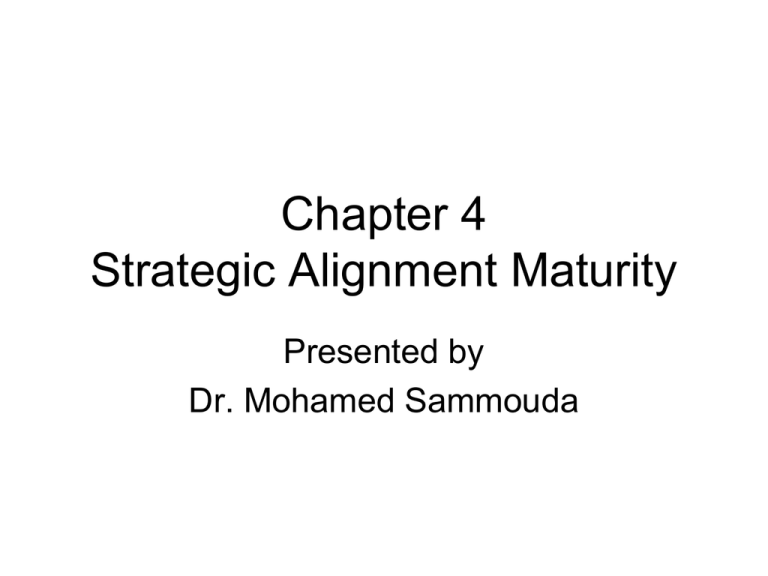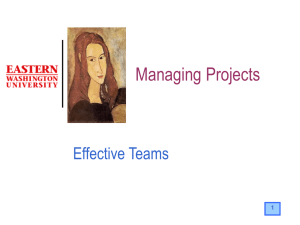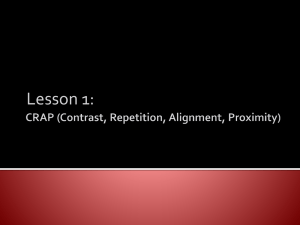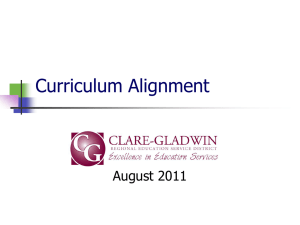Chapter 4: Strategic Alignment Maturity
advertisement

Chapter 4 Strategic Alignment Maturity Presented by Dr. Mohamed Sammouda Chapter Outline • • • • • Importance of IT and business environment Enablers and inhibitors to alignment Concept/importance of alignment maturity 5 levels of Strategic Alignment Maturity 6 Criteria that characterize levels of Strategic Alignment Model • Assessing Strategic Alignment Maturity • Strategic Alignment Process Importance of Alignment • Effectiveness • Efficiency • Link Technology and Business IT Management Should: • Be knowledgeable about how new IT technologies can be integrated into business • Be privy to senior management's tactical and strategic plans • Be present when corporate strategies are discussed • Understand strengths and weaknesses of technologies and implications Alignment Maturity • Process which evaluates the IT/business alignment status of a specific organization – It has a defined number of levels and representations (5 levels) – It is based on a defined set of criteria (six key criteria) 5 Strategic Alignment Maturity Levels 1. Initial/Ad Hoc Process Business and IT not aligned 2. Committed Process Organization commits to becoming aligned 3. Established Focused Process Established and Focused on business objectives 4. Improved/Managed Process Reinforcing concept of IT as “Value Center” 5. Optimized Process Integrated/Co-adaptive business and IT strategic planning Strategic Alignment Maturity Criteria/Elements 1. 2. 3. 4. 5. 6. Communications Competency/value measurements Governance Partnerships Scope and Architecture Skills 1-Communications • • • • Ensure ongoing knowledge sharing Use people in formal inter-unit liaison roles Cooperation among business-IT partners Trust and openness between units and IT 2-Competency/Value Measurements • Service levels that assess commitment of IT • Tie service levels to criteria • Take action based on measurements of performance factors • Understand factors that lead to missing criteria • Understand what can be learned to improve the environment continuously 3-Governance • Clearly defined decision-making authority • Integrated enterprise-wide strategic business plan 4-Partnership • Relationship between business and IT organizations • Give IT function equal role in defining business strategy • Perception of contributions • Partnership should enable and drive change 5-Scope and Architecture • Go beyond back office and into front office • Assume role supporting flexible infrastructure • Evaluate and apply emerging technologies effectively • Enable or drive business processes and strategies • Provide solutions customizable to customer needs 6-Skills • Include all human resource considerations for organization • Consider cultural and social environment Measuring alignment Where are we in terms of Luftman’s triangle? Complexity of 5 levels and 1. Initial ad hoc 2. Committed process 3. Established focused 4. Improved/managed 5. Optimised process 6 variables: 1. Skills 2. Scope and architecture 3. Partnership 4. Governance 5. Competency/value 6. Communications Climbing the Strategic Alignment Maturity Model LEVEL 5 Optimized Process LEVEL 4 Improved Process Business Strategy LEVEL 3 Established process LEVEL 2 Committed Process LEVEL 1 Initial Process Alignment Gap IT Strategy The structure of the CMM OPTIMIZING (5) Continuously Improving Process These are the KPAs associated with each level: • DEFECT PREVENTION PROCESS • TECHNOLOGY CHANGE MANAGEMENT • PROCESS CHANGE MANAGEMENT MANAGED (4) Predictable Process • QUANTITATIVE PROCESS MANAGEMENT • SOFTWARE QUALITY MANAGEMENT DEFINED (3) Standard, Consistent Process Disciplined Process INITIAL (1) • ORGANIZATION PROCESS FOCUS • ORGANIZATION PROCESS DEFINITION • TRAINING PROGRAM • INTEGRATED SOFTWARE MANAGEMENT • SOFTWARE PRODUCT ENGINEERING • INTERGROUP COORDINATION • PEER REVIEWS REPEATABLE (2) • REQUIREMENTS MANAGEMENT • SOFTWARE PROJECT PLANNING • SOFTWARE PROJECT TRACKING AND OVERSIGHT • SOFTWARE SUBCONTRACT MANAGEMENT • SOFTWARE QUALITY ASSURANCE • SOFTWARE CONFIGURATION MANAGEMENT An organization is not considered to be at a given level until it has satisfied the conditions for every Key Process Area through that level. People Capability Maturity Model 5.Optimizing Continuously improve methods for developing personal and organizational Competence Continuous Workforce Innovation Coaching Personal Competency Development 4.Managed Quantitatively manage organizational growth in workforce capabilities and establish competency-based teams Organizational Performance Alignment Organizational Competency Management Team-Based Practices Team Building Mentoring 3.Defined Identify core competencies and align workforce activities with them Participatory Culture Competency-Based Practices Career Development Competency Development Workforce Planning Knowledge and Skills Analysis 2.Repeatable Instill basic discipline into workforce activities Compensation Training Performance Management Staffing Communication Work Environment 1.Initial COMPETENCY/VALUE MEASUREMENTS COMMUNICATIONS •Understanding of Business by IT •Understanding of IT by Business •Inter/Intra - organizational Learning/Education •Protocol Rigidity •Knowledge Sharing •Liaison(s) effectiveness · •IT Metrics •Business Metrics •Balanced Metrics •Service Level Agreements •Benchmarking •Formal Assessments/Reviews •Continuous Improvement GOVERNANCE •Business Strategic Planning •IT Strategic Planning •Organization Structure Reporting/ •Budgetary Control •IT Investment Management •Steering Committee(s) •Prioritization Process IT BUSINESS ALIGNMENT MATURITY CRITERIA PARTNERSHIP · · · · · · •Business Perception of IT Value •Role of IT in Strategic c Business Planning •Shared Goals, Risk, Rewards/Penalties •IT Program Management •Relationship/Trust Style •Business Sponsor/Champion SCOPE & ARCHITECTURE •Traditional, Enabler/Driver, External •Standards Articulation •Architectural Integration: - - Functional Organization -Enterprise -Inter - Inter - enterprise •Architectural Transparency, Agility, Flexibility •Manage Emerging Tech. SKILLS •Innovation, Entrepreneurship •Cultural Locus of Power •Management Style •Change Readiness •Career cro ssover training •Social, Political, Education, Cross- Trusting Interpersonal Environment •Hiring and retaining COMMUNICATIONS • Understanding of Business by IT • Understanding of IT by Business - • Inter / Intra-organizational Learning / Education · COMPETENCY/VALUE MEASUREMENTS GOVERNANCE •Business Strategic Planning •IT Metrics •IT Strategic Planning • Protocol rigidity •Business Metrics •Organization Structure • Knowledge Sharing •Service Level Agreements • Liaison(s) effectiveness •Formal Assessments/Reviews •Balanced Metrics •Benchmarking •Continuous Improvement •Budgetary Control •IT Investment Management •Steering Committee(s) •Prioritization Process IT BUSINESS ALIGNMENT MATURITY CRITERIA PARTNERSHIP •Business Perception of IT Value •Role of IT in Strategic SCOPE & ARCHITECTURE c Business Planning •Shared Goals, Risk, Rewards/Penalties •IT Program Management •Relationship/Trust Style •Business Sponsor/Champion •Traditional, Enabler/Driver, External •Standards Articulation •Architectural Integration: - Functional Organization -Enterprise -Inter enterprise •Architectural Transparency, Agility, Flexibility •Manage Emerging Tech. SKILLS •Innovation, Entrepreneurship •Cultural Locus of Power •Management Style •Change Readiness Education, Cross•Career cro ssover training •Social, Political, Trusting Interpersonal Environment •Hiring and retaining COMPETENCY / VALUE MEASUREMENTS • IT Metrics • Business Metrics COMMUNICATIONS •Understanding of Business by IT •Understanding of IT by Business •Inter/Intra organizational Learning/Education •Protocol Rigidity •Knowledge Sharing effectiveness •Liaison(s) • Balanced Metrics GOVERNANCE • Service Level Agreements · •Business Strategic Planning • Benchmarking •Organization Structure • Formal Assessments / Reviews • Continuous Improvement •IT Strategic Planning •Budgetary Control •IT Investment Management •Steering Committee(s) •Prioritization Process IT BUSINESS ALIGNMENT MATURITY CRITERIA PARTNERSHIP •Business Perception of IT Value •Role of IT in Strategic SCOPE & ARCHITECTURE c Business Planning •Shared Goals, Risk, Rewards/Penalties •IT Program Management •Relationship/Trust Style •Business Sponsor/Champion •Traditional, Enabler/Driver, External •Standards Articulation •Architectural Integration: - Functional Organization -Enterprise -Inter enterprise •Architectural Transparency, Agility, Flexibility •Manage Emerging Tech. SKILLS •Innovation, Entrepreneurship •Cultural Locus of Power •Management Style •Change Readiness Education, Cross•Career cro ssover training •Social, Political, Trusting Interpersonal Environment •Hiring and retaining GOVERNANCE • Business Strategic Planning • IT Strategic Planning COMMUNICATIONS •Understanding of Business by IT •Understanding of IT by Business •Inter/Intra organizational Learning/Education •Protocol Rigidity •Knowledge Sharing effectiveness •Liaison(s) COMPETENCY/VALUE MEASUREMENTS •IT Metrics •Business Metrics •Balanced Metrics •Service Level Agreements •Benchmarking •Formal Assessments/Reviews • Organization Structure • Budgetary Control • IT Investment Management • Steering Committee(s) • Prioritization Process •Continuous Improvement IT BUSINESS ALIGNMENT MATURITY CRITERIA PARTNERSHIP •Business Perception of IT Value •Role of IT in Strategic c Business Planning •Shared Goals, Risk, Rewards/Penalties •IT Program Management •Relationship/Trust Style •Business Sponsor/Champion SCOPE & ARCHITECTURE •Traditional, Enabler/Driver, External •Standards Articulation •Architectural Integration: - Functional Organization -Enterprise -Inter enterprise •Architectural Transparency, Agility, Flexibility •Manage Emerging Tech. SKILLS •Innovation, Entrepreneurship •Cultural Locus of Power •Management Style •Change Readiness Education, Cross•Career cro ssover training •Social, Political, Trusting Interpersonal Environment •Hiring and retaining COMMUNICATIONS •Understanding of Business by IT •Understanding of IT by Business •Inter/Intra organizational Learning/Education •Protocol Rigidity •Knowledge Sharing effectiveness •Liaison(s) COMPETENCY/VALUE MEASUREMENTS GOVERNANCE •Business Strategic Planning •IT Metrics •IT Strategic Planning •Business Metrics •Organization Structure •Balanced Metrics •Service Level Agreements •Benchmarking •Formal Assessments/Reviews •Budgetary Control •IT Investment Management •Steering Committee(s) •Prioritization Process •Continuous Improvement IT BUSINESS ALIGNMENT MATURITY CRITERIA PARTNERSHIP • Business Perception of IT Value • Role of IT in Strategic Business Planning • Shared Goals, Risk, Rewards/Penalties • IT Program Management • Relationship / Trust Style • Business Sponsor / Champion SCOPE & ARCHITECTURE •Traditional, Enabler/Driver, External •Standards Articulation •Architectural Integration: - Functional Organization -Enterprise -Inter enterprise •Architectural Transparency, Agility, Flexibility •Manage Emerging Tech. SKILLS •Innovation, Entrepreneurship •Cultural Locus of Power •Management Style •Change Readiness •Career cro ssover training •Social, Political, Trusting Interpersonal Environment •Hiring and retaining COMMUNICATIONS •Understanding of Business by IT •Understanding of IT by Business •Inter/Intra organizational Learning/Education •Protocol Rigidity •Knowledge Sharing effectiveness •Liaison(s) COMPETENCY/VALUE MEASUREMENTS GOVERNANCE •Business Strategic Planning •IT Metrics •IT Strategic Planning •Business Metrics •Organization Structure •Balanced Metrics •Service Level Agreements •Benchmarking •Formal Assessments/Reviews •Budgetary Control •IT Investment Management •Steering Committee(s) •Prioritization Process •Continuous Improvement IT BUSINESS ALIGNMENT MATURITY CRITERIA PARTNERSHIP •Business Perception of IT Value •Role of IT in Strategic c Business Planning •Shared Goals, Risk, Rewards/Penalties •IT Program Management •Relationship/Trust Style •Business Sponsor/Champion SCOPE & ARCHITECTURE • Traditional, Enabler / Driver, External • Standards Articulation • Architectural Integration: • Functional Organization • Enterprise • Inter enterprise • Architectural Transparency, Agility, Flexibility • Manage Emerging Tech. SKILLS •Innovation, Entrepreneurship •Cultural Locus of Power •Management Style •Change Readiness •Career cro ssover training •Social, Political, Trusting Interpersonal Environment •Hiring and retaining COMMUNICATIONS •Understanding of Business by IT •Understanding of IT by Business •Inter/Intra organizational Learning/Education •Protocol Rigidity •Knowledge Sharing effectiveness •Liaison(s) COMPETENCY/VALUE MEASUREMENTS GOVERNANCE •Business Strategic Planning •IT Metrics •IT Strategic Planning •Business Metrics •Organization Structure •Balanced Metrics •Service Level Agreements •Benchmarking •Formal Assessments/Reviews •Budgetary Control •IT Investment Management •Steering Committee(s) •Prioritization Process •Continuous Improvement IT BUSINESS ALIGNMENT MATURITY CRITERIA PARTNERSHIP •Business Perception of IT Value •Role of IT in Strategic c Business Planning •Shared Goals, Risk, Rewards/Penalties •IT Program Management •Relationship/Trust Style •Business Sponsor/Champion SCOPE & ARCHITECTURE •Traditional, Enabler/Driver, External •Standards Articulation •Architectural Integration: - Functional Organization -Enterprise -Inter enterprise •Architectural Transparency, Agility, Flexibility •Manage Emerging Tech. SKILLS • Innovation Entrepreneurship • Cultural Locus of Power • Management Style • Change Readiness • Career crossover training • Social, Political, Trusting Interpersonal Environment • Hiring and retaining COMPETENCY/VALUE MEASUREMENTS COMMUNICATIONS •Understanding of Business by IT •Understanding of IT by Business •Inter/Intra - organizational Learning/Education •Protocol Rigidity •Knowledge Sharing •Liaison(s) effectiveness · •IT Metrics •Business Metrics •Balanced Metrics •Service Level Agreements •Benchmarking •Formal Assessments/Reviews •Continuous Improvement GOVERNANCE •Business Strategic Planning •IT Strategic Planning •Organization Structure Reporting/ •Budgetary Control •IT Investment Management •Steering Committee(s) •Prioritization Process IT BUSINESS ALIGNMENT MATURITY CRITERIA PARTNERSHIP · · · · · · •Business Perception of IT Value •Role of IT in Strategic c Business Planning •Shared Goals, Risk, Rewards/Penalties •IT Program Management •Relationship/Trust Style •Business Sponsor/Champion SCOPE & ARCHITECTURE •Traditional, Enabler/Driver, External •Standards Articulation •Architectural Integration: - - Functional Organization -Enterprise -Inter - Inter - enterprise •Architectural Transparency, Agility, Flexibility •Manage Emerging Tech. SKILLS •Innovation, Entrepreneurship •Cultural Locus of Power •Management Style •Change Readiness •Career cro ssover training •Social, Political, Education, Cross- Trusting Interpersonal Environment •Hiring and retaining Level 5 Strategic Alignment Maturity Summary Level 3 Level 4 •Optimized process •COMMUNICATIONS: Informal, pervasive •COMPETENCY/VALUE: Extended to external partners •GOVERNANCE: Integrated across the org & partners •PARTNERSHIP: IT-business co-adaptive/improvisational •SCOPE & ARCHITECTURE: Evolve with partners •SKILLS: Education/careers/rewards across the organization •Improved/ managed process •COMMUNICATIONS: Bonding, unified •COMPETENCY/VALUE: Cost effective;Some partner value;Dashboard managed •GOVERNANCE: Managed across the organization •PARTNERSHIP: IT enables/drives business strategy •SCOPE & ARCHITECTURE: Integrated with partners •SKILLS: Shared risk & rewards •Established focused process •COMMUNICATIONS: Good understanding; Emerging relaxed •COMPETENCY/VALUE: Some cost effectiveness; Dashboard established •GOVERNANCE: Relevant process across the organization •PARTNERSHIP: IT seen as an asset; Process driver;Conflict seen as creative •SCOPE & ARCHITECTURE: Integrated across the organization •SKILLS: Emerging value service provider;Balanced tech & business hiring Level 2 Level 1 •Committed process •COMMUNICATIONS: Limited business/IT understanding •COMPETENCY/VALUE: Functional cost efficiency •GOVERNANCE: Tactical at Functional level,occasional responsive •PARTNERSHIP: IT emerging as an asset; Process enabler •SCOPE & ARCHITECTURE: Transaction (e.g., ESS, DSS) •SKILLS: Differs across functional organizations •Initial/Ad-Hoc process •COMMUNICATIONS: Business/IT lack understanding •COMPETENCY/VALUE: Some technical measurements •GOVERNANCE: No formal process,cost center, reactive priorities •PARTNERSHIP: Conflict; IT a cost of doing business •SCOPE & ARCHITECTURE: Traditional (e.g., acctng, email) •SKILLS: IT takes risk, little reward; Technical training Strategic Level 5 •Optimized process Alignment •COMMUNICATIONS: Informal, pervasive •COMPETENCY/VALUE: Extended to external partners Maturity •GOVERNANCE: Integrated across the org & partners Summary •PARTNERSHIP: IT-business co-adaptive/improvisational •SCOPE & ARCHITECTURE: Evolve with partners •SKILLS: Education/careers/rewards across the organization Level 1 •Initial/Ad-Hoc process •COMMUNICATIONS: Business/IT lack understanding •COMPETENCY/VALUE: Some technical measurements •GOVERNANCE: No formal process,cost center, reactive priorities •PARTNERSHIP: Conflict; IT a cost of doing business •SCOPE & ARCHITECTURE: Traditional (e.g., acctng, email) •SKILLS: IT takes risk, little reward; Technical training Primary Objective of Assessment: • Agree that criterion needs to be improved • Agree that a criterion is good, but can be better • Disagree with how good/bad a criterion is Level 1 – Initial/Ad Hoc Process • Lowest level of strategic alignment • Understanding of IT by business is low • Investment in IT is underleveraged Level 2 – Committed Process • Committed to begin process for Strategic Alignment Maturity • View IT as an asset to the organization • Directed at local situations or functional organizations • Alignment at the level is difficult to achieve • Potential opportunities are recognized Level 3 – Established Focused Process • Concentrates on governance, processes, and communications toward specific business objectives • Needs better governance to invest IT dollars • Focus on business processes that generate long-lasting competitive advantage • Effectively communicate its vision and get “buy-in” from employees and management Level 4 – Improved/Managed Process • Leverage IT assets on an enterprise-wide basis • Focus on driving business process enhancements to gain competitive advantage • Views IT as an innovative and imaginative strategic contributor • Capitalize on information and knowledge • Utilize IT assets by deploying enterprise-wide architecture Assessing Strategic Alignment Maturity • This does not fit the organization, or the organization is not very effective • Low level of fit for the organization • Moderate fit for the organization, or the organization is moderately effective • Fits most of the organization • Strong level of fit throughout the organization, or the organization is effective Strategic Alignment Process • • • • • • Set the Goals and Establish a Team Understand the Business-IT Logic Analyze and Prioritize Gaps Specify the Actions (Project Management) Choose and Evaluate Success Criteria Sustain Alignment







